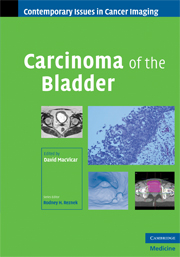Book contents
- Frontmatter
- Contents
- Contributors
- Series foreword
- Preface to Carcinoma of the Bladder
- 1 The pathology of bladder cancer
- 2 Clinical features of bladder cancer
- 3 Imaging in the diagnosis of bladder cancer
- 4 Radiological staging of primary bladder cancer
- 5 Imaging of metastatic bladder cancer
- 6 Surgery for bladder cancer
- 7 External beam radiotherapy for the treatment of muscle invasive bladder cancer
- 8 The chemotherapeutic management of bladder cancer
- 9 Clinical follow-up of bladder cancer
- 10 Imaging of treated bladder cancer
- Index
- Plate section
- References
9 - Clinical follow-up of bladder cancer
Published online by Cambridge University Press: 25 August 2009
- Frontmatter
- Contents
- Contributors
- Series foreword
- Preface to Carcinoma of the Bladder
- 1 The pathology of bladder cancer
- 2 Clinical features of bladder cancer
- 3 Imaging in the diagnosis of bladder cancer
- 4 Radiological staging of primary bladder cancer
- 5 Imaging of metastatic bladder cancer
- 6 Surgery for bladder cancer
- 7 External beam radiotherapy for the treatment of muscle invasive bladder cancer
- 8 The chemotherapeutic management of bladder cancer
- 9 Clinical follow-up of bladder cancer
- 10 Imaging of treated bladder cancer
- Index
- Plate section
- References
Summary
Superficial bladder cancer
Cystoscopic follow-up
There is no doubt that cystoscopy remains the gold standard of follow-up for patients who have undergone a transurethral resection (TUR) of a superficial bladder cancer. The majority will undergo a flexible cystoscopy, which obviates the need for a general or spinal anesthetic and which is very well tolerated. A flexible cystoscopy allows the regular inspection of the urethra and the whole bladder with a low morbidity and low cost. With modern videocystoscopes and experience, even very small recurrences can be readily detected. The interpretation of flat mucosal lesions is, however, difficult.
The first check cystoscopy is performed three months following the initial TUR apart from in those cases where there is a question over the grade (G2 or G3) or when there is uncertainity as to the depth of invasion of the tumor. In such cases, an early repeat resection or biopsy is made at the site of the initial tumor (4–6 weeks) [1]. However, although some doubt that the repeat early TUR has any effect on the subsequent outcome of these cases, it has been shown to reduce recurrences and improve prognosis. Indeed, there is a 10% chance that a G3TaT1 tumor has been understaged and is therefore a muscle invasive tumor [1–3]. The treatment of muscle invasive bladder tumors is completely different to that of superficial bladder tumors (see Chapter 6).
There are two main questions regarding the follow-up of patients after treatment for superficial bladder cancer. These are
At what sort of frequency should follow-up occur?
[…]
- Type
- Chapter
- Information
- Carcinoma of the Bladder , pp. 137 - 146Publisher: Cambridge University PressPrint publication year: 2008

